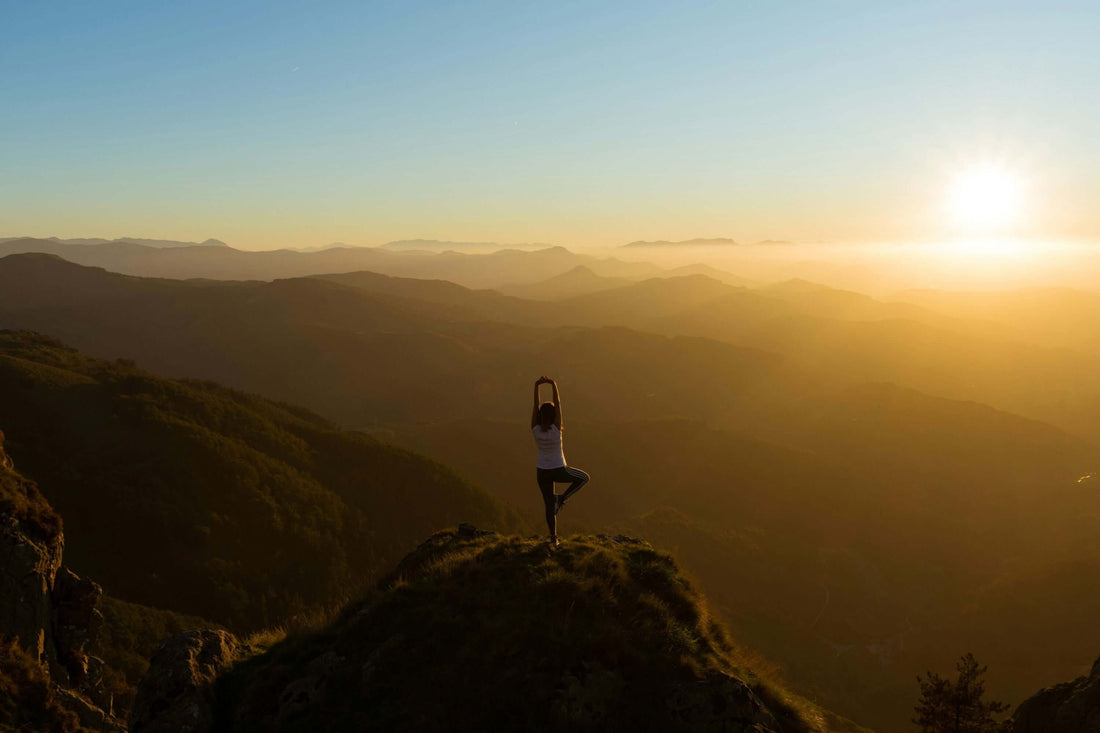
How Yoga Can Improve Your Well-Being
Share
Many people hesitate to start practicing yoga due to misconceptions about flexibility, fitness levels, or simply not knowing where to begin. However, yoga is a powerful tool for self-care, benefiting both the body by enhancing flexibility, strength, and balance, and the mind by reducing stress, improving mental clarity, and promoting relaxation.
Yoga is considered a mindfulness practice, encouraging presence and awareness in every breath and posture.
Let's explore how yoga can transform your self-care routine, the various types of yoga, and practical tips to get you started.

Getting Started with Yoga
Create a Comfortable Space
Create a comfortable space for yourself where you feel safe and free of distractions (unless it's a furry companion). A quiet corner in your home with enough space to stretch out is all you need. This could be your living room, bedroom, or even a spot in your backyard. The goal is to have a clean, clutter-free area where you feel comfortable and relaxed.
Gear Up
A good yoga mat is essential for grip and comfort. Blocks, straps, and blankets can be helpful but are not necessary for beginners. Start simple and see what additional props you might need as you progress.
Start with Online Resources
If you’re not ready to join a class, online resources are a fantastic way to begin. Websites like YouTube have countless free yoga tutorials for all levels. Channels like Yoga with Adriene and Fightmaster Yoga offer beginner-friendly videos that you can do at your own pace, in the comfort of your home.
Join a Local Class
When you feel ready, consider joining a local yoga class. This can be a great way to learn proper techniques and stay motivated. If you live in Hoofddorp or nearby, La Luna offers a variety of classes, including Yin Yoga, Vinyasa, Hatha, and Prenatal Yoga. These classes cater to different needs and skill levels, so you can find one that fits your preferences.
Embrace Being a Beginner
Starting something new can be intimidating, especially if you’re not very flexible or fit. Remember, yoga is for everyone, regardless of your starting point. The beauty of yoga is that it meets you where you are. Focus on your progress, not perfection.
The beauty of yoga is that it meets you where you are. Focus on your progress, not perfection.
Tips for Practicing Yoga
Consistency Over Intensity
It’s better to practice for a few minutes every day than to do a long session once a week. Consistency helps build a routine and makes yoga a natural part of your day.
Listen to Your Body
Yoga is about connecting with your body. Pay attention to how you feel during and after each session. If a pose doesn’t feel right, modify it or skip it. There’s no one-size-fits-all in yoga.
Focus on Your Breath
Breathwork is a key component of yoga. Focusing on your breath helps you stay present and enhances the physical and mental benefits of your practice. Try to sync your movements with your breath for a deeper experience.
Explore Different Styles
Yoga comes in many forms, and it’s worth exploring different styles to find what you enjoy the most.
Here are some common types:

Most Common Types of Yoga
Hatha Yoga
Hatha Yoga focuses on basic postures and breathing techniques. It’s often slower-paced and is excellent for beginners who want to learn the fundamentals. Hatha Yoga emphasizes alignment and deliberate movement, making it a great practice for those who want to build a solid foundation. It's also beneficial for increasing flexibility and strength, promoting relaxation, and reducing stress.
Vinyasa Yoga
Vinyasa Yoga is dynamic and flowing, linking movement with breath. This style can be more vigorous and is great for building strength and flexibility. Vinyasa Yoga involves synchronizing your breath with a continuous flow of poses, creating a sequence that feels like a dance. The focus on breathwork also helps calm the mind and reduce stress.
Ashtanga Yoga
Ashtanga Yoga is a rigorous style of yoga that follows a specific sequence of postures and is similar to vinyasa yoga, but faster-paced. It requires strength and endurance and is typically more physically demanding. Ashtanga is great for those looking for a challenging workout.
Yin Yoga
Yin Yoga involves holding poses for longer periods, typically three to five minutes. This practice targets the deep connective tissues, such as ligaments, bones, and even the joints that are often overlooked in more active styles of yoga. The extended time spent in each pose helps increase flexibility and improve circulation in the joints. Yin Yoga encourages a meditative approach, allowing you to turn inward and tune into both your mind and the physical sensations of your body. This type of yoga is especially beneficial for stress relief and mental clarity.
Bikram/Hot Yoga
Bikram Yoga, often referred to as Hot Yoga, is practiced in a room heated to around 105°F (40°C) with 40% humidity. This style follows a set sequence of 26 poses and two breathing exercises. The heat allows for deeper stretching and helps detoxify the body through sweat. Bikram Yoga can be intense but is beneficial for building strength, flexibility, and mental discipline.

Benefits of Doing Yoga
Physical Benefits
- Improves Flexibility: Regular practice helps to increase your flexibility, reducing the risk of injuries.
- Builds Strength: Yoga poses engage various muscle groups, helping to build and tone muscle.
- Enhances Balance: Many yoga poses improve balance and coordination, which is beneficial for overall stability.
- Boosts Circulation: Yoga encourages blood flow and improves circulation, which can enhance overall health.
Mental Benefits
- Reduces Stress: Yoga promotes relaxation through breathwork and mindfulness, helping to reduce stress and anxiety.
- Enhances Mental Clarity: The focus required in yoga can improve concentration and mental clarity.
- Promotes Relaxation: The combination of physical movement and breathwork can help you relax and improve sleep quality.
- Improves Mood: Regular practice can boost your mood and increase feelings of well-being.
Enhancing Your Yoga Practice with Aromatherapy
Aromatherapy can significantly enhance your yoga practice by creating a calming environment and promoting relaxation. Essential oils, such as lavender, eucalyptus, and peppermint, can be used to enhance the benefits of yoga.
How to Use Aromatherapy
- Aromatherapy Candles: Light a candle with essential oils before starting your session. The gentle flicker and soothing scent can help create a serene atmosphere.
- Diffusing Oils: Use an essential oil diffuser during your yoga session to fill the room with calming scents.
- Topical Application: Dilute essential oils with a carrier oil and apply to your wrists, temples, or the back of your neck before practice.
Incorporating aromatherapy into your yoga routine can deepen your sense of relaxation and make your practice even more enjoyable. For a selection of aromatherapy candles designed to enhance your yoga practice, check out our aromatherapy candles.
Conclusion
Yoga is a versatile practice that offers numerous benefits for both the body and mind. Whether you’re looking to improve your physical health, reduce stress, or enhance your overall well-being, yoga has something to offer. Remember, it’s okay to be a beginner. Start where you are, and enjoy the journey. If you're in the Hoofddorp area, consider checking out La Luna for a variety of classes tailored to different needs and skill levels. Happy practicing!
